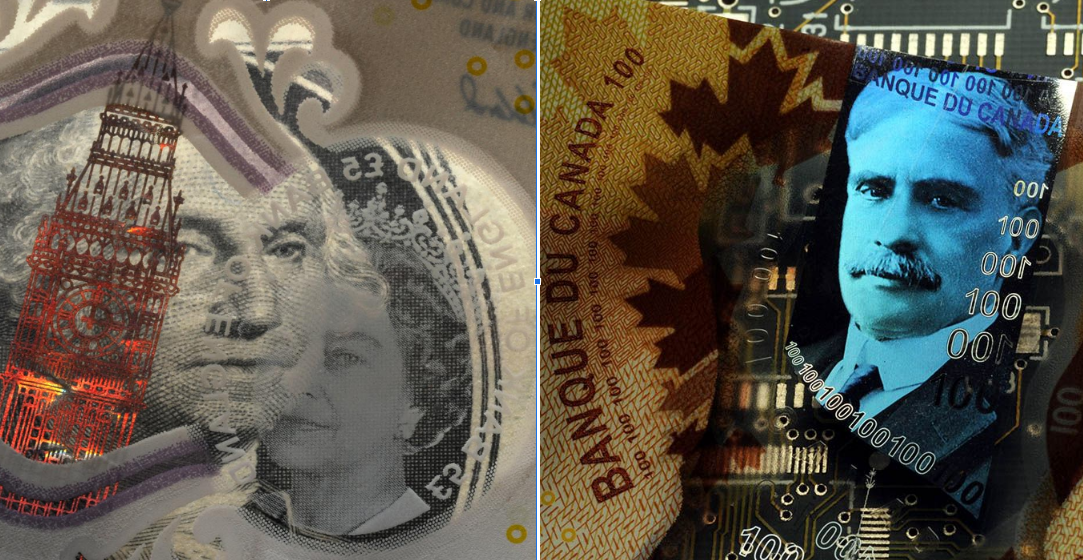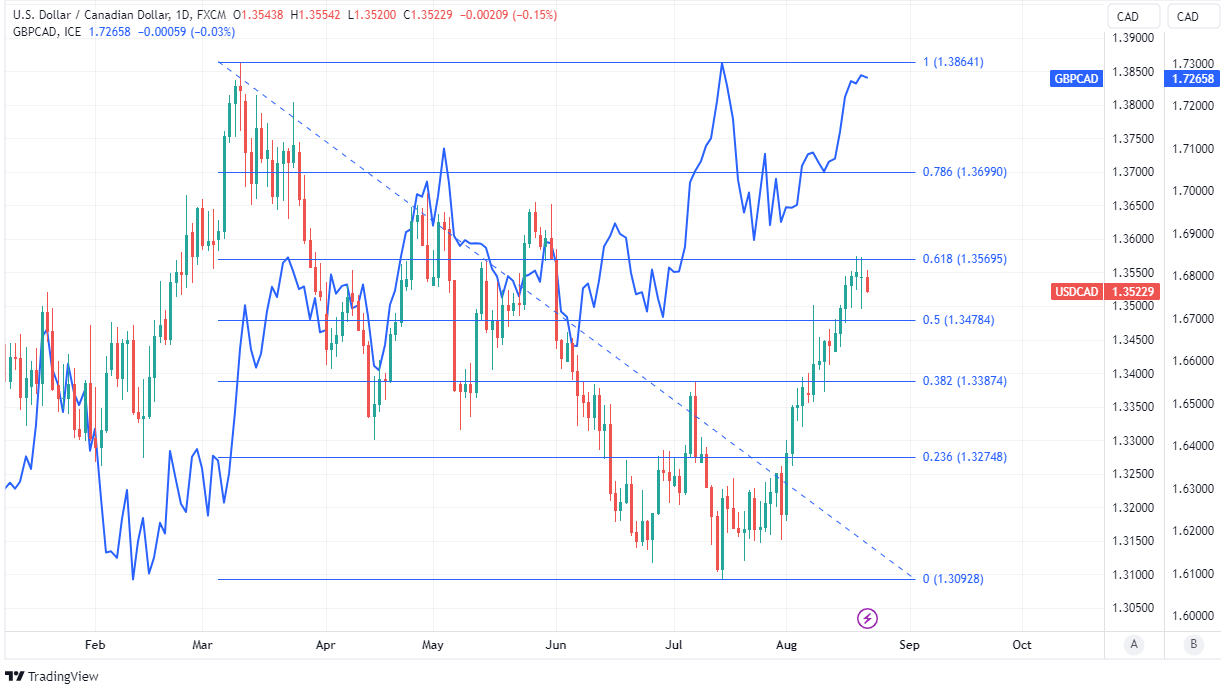GBP/CAD Upside Constrained as Correction Risk Rises
- GBP/CAD near early 2022 highs but struggling with 1.73
- Technical support offered at 1.7039 on charts short-term
- S&P surveys, CA retail sales, USD, Fed & RMB in focus

Image © Pound Sterling Live
The Pound to Canadian Dollar exchange rate was struggling for momentum near one-month highs early in the new week after an eight percent rally from February lows appeared to stall just above 1.73 in the middle of July and the risk is now of a correction entailing a setback as far as the 1.7039 area in the days or weeks ahead.
Canada's Dollar remains a middle of the road performer among major currencies throughout the recent week, month and for the current year following an August run of losses that has helped lift GBP/CAD back near to 1,73 and seen the Loonie slide back to major support around 1.3569 on the charts against the U.S. Dollar.
But Sterling was in retreat from the Loonie by Tuesday with the latter climbing off recent lows against a softer greenback ahead of the midweek release of S&P Global PMI surveys from the UK and retail sales figures from Canada, which could risk further dampening the rally in GBP/CAD over the coming days.
"Despite negative price action on the weekly chart around the July high (a bearish “engulfing line”), the GBP remains well-supported on dips. The broader bull trend remains intact," writes Shaun Osborne, chief FX strategist at Scotiabank, in a recent review of the Canadian Dollar charts.
"A retest of the July high is within reach from here, I think, given the positioning of the DMI signals. New cycle highs would be a clear positive and point to additional strength ahead. 1.7528 is the 50% retracement of the GBP’s 2016-2022 decline, with gains towards the 1.77/1.78 range (the upper zone of long run congestion) possible above there," he adds.

Above: Pound to Canadian Dollar rate shown at daily intervals with Fibonacci retracements of February rally indicating possible areas of technical support for Sterling.
Any midweek continuation of this year's downtrend in the S&P Global surveys of UK manufacturing and services sectors is the biggest near-term risk for GBP/CAD and likewise, if economists are right to anticipate a notable rebound in Canadian retail sales later in the midweek trading session.
"Canadian retail sales data for June, released Wednesday, will give us the latest update on the health of consumer spending and a better idea of how the next GDP report could print," says Jay Zhao-Murray, a Canada-based FX analyst at Monex Europe.
"StatsCan’s advance estimate, which is based on a survey response rate of 48%, points to an even softer reading for June, with no growth expected," he adds.
Wednesday's retail sales figures will follow hard on the heels of last week's mixed Canadian inflation report for July in which overall price growth crept higher to 3.3% and the core inflation rate remained stubborn at 3.2% with this data coming closely behind several labour market reports offering signs of rising unemployment.
It's not yet clear what these developments will mean for the Bank of Canada (BoC) though unemployment has also begun to tick higher in the UK while recent retail sales numbers were much softer than expected, suggesting increases in the Bank of England (BoE) Bank Rate are now being felt by the labour market backbone of the economy.

Above: USD/CAD at daily intervals with Fibonacci retracements of March fall indicating possible areas of technical resistance for Sterling and shown alongside GBP/CAD.
"PMIs tomorrow will be the decider for where we end up on the week excluding Jackson Hole/China moves," says Jordan Rochester, a strategist at Nomura, of this week's UK data.
Beyond Wednesday, however, the risks for GBP/CAD result more from developments in the U.S. where Federal Reserve (Fed) commentary at the Jackson Hole Symposium in Wyoming on Thursday and Friday is likely to influence the direction of bond yields and other global markets.
"After a few weeks of gains, we may see some position squaring ahead of Powell's speech this Friday, but the speech itself is likely to remain slightly combative," says Joe Tuckey, head of FX analysis at London Stock Exchange listed foreign exchange specialist Argentex.
"It’s of course premature to declare victory on inflation and, on rates, he may allude to ‘higher for longer’, as opposed to signaling a lofty terminal rate. Whilst a hawkish Powell could support the dollar, markets may have largely discounted such hawkish overtures in the recent dollar rally,” he adds.
Additionally, through the remainder of the week developments in China and the machinations of its monetary policy relating to the managed-floating Renminbi are likely to be one of many other influences on risk appetite and exchange rates around the world including those of advanced economy currencies like Sterling.

Above: GBP/CAD at weekly intervals with Fibonacci retracements of 2018 rally indicating possible areas of technical resistance for Sterling and shown alongside GBP/USD.
"Regarding currency stability, the PBoC has further declared its readiness to implement corrective measures when necessary. These measures aim to counteract pro-cyclical and one-sided market behaviors that could lead to harmful volatility," says Tommy Xie, head of Greater China research at OCBC.
"By taking decisive action when needed, the central bank is demonstrating its commitment to firmly guard against the risk of excessive exchange rate fluctuations, ensuring that the Chinese yuan remains at a fundamentally stable level of reasonable equilibrium," he adds.
The Renminbi has fallen heavily and particularly against the Dollar in recent months but if these losses are accepted by the monetary authority then the policy preference for keeping the overall or trade-weighted Renminbi "basically stable," implies that the same policy then acts to support other parts of the market including potentially Sterling and the Loonie.
Renminbi losses have built sharply this year amid heightening concern among analysts about the likely condition of the domestic Chinese economy due to structural reforms the government has been implementing since 2021, though some are as concerned about the downside risks in developed markets as they are the Chinese ones.
"Given months of negative macro data, real estate concerns, contagion risks via wealth management products and the shadow banking system, you may be surprised that 3-month 90% put options on the China A50 index cost less than those on the S&P500," says Riddhi Prasad, an equity-linked security analyst at BofA Global Research.
